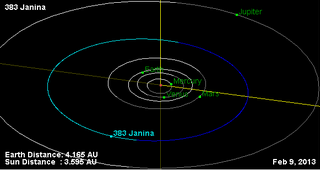
Silesia is a large Main belt asteroid, about 73 kilometers in diameter. It was discovered by Johann Palisa on 5 April 1886 at Vienna Observatory, Austria.

Tyche is a relatively large main belt asteroid discovered by Robert Luther at Düsseldorf-Bilk Observatory on 4 May 1886. The stony S-type asteroid measures about 65 kilometers in diameter and has a perihelion of 2.1 AU.

Theresia is a typical Main belt asteroid. It was discovered by Johann Palisa on 17 August 1890 in Vienna.

Phaeo is an asteroid from the central regions of the asteroid belt, approximately 70 kilometers in diameter. It was discovered on 27 November 1891, by French astronomer Alphonse Borrelly at the Marseille Observatory in southern France. The presumably metallic X-type asteroid is the principal body of the Phaeo family and has a rotation period of 17.6 hours. It was named for the Greek mythological figure Phaeo, one of the Hyades or nymphs. Several other asteroids were named for other of the Hyades – 106 Dione, 158 Koronis, 217 Eudora, and 308 Polyxo.

Tamara is a large Main belt asteroid. It is classified as a C-type asteroid and is probably composed of carbonaceous material. It is the largest member and namesake of the Tamara Family, a 264 million year-old sub-family of the collisional Phocaea family.

Etheridgea is a large main belt asteroid. It was discovered by Auguste Charlois on 1 April 1892 in Nice. The meaning of the name is unknown. This asteroid is orbiting the Sun at a distance of 3.02 AU with a period of 5.26 years and an eccentricity (ovalness) of 0.10. The orbital plane is tilted at an angle of 6.05° to the plane of the ecliptic.

Endymion is a large Main belt asteroid. It was discovered by Max Wolf on 17 October 1892 in Heidelberg. It was the first asteroid to receive the name of a male god.

Desiderata is a very large main-belt asteroid. It is classified as a C-type asteroid and is probably composed of carbonaceous material.

Ornamenta is a relatively large main-belt asteroid, measuring 118 km in diameter. It is classified as a C-type asteroid and is probably composed of carbonaceous material.

Georgia is a typical Main belt asteroid. It is classified as an X-type asteroid.

Burgundia is a typical main belt asteroid that was discovered by Auguste Charlois on 18 September 1893 in Nice. It was named for the former French region of Burgundy. It is one of seven of Charlois's discoveries that was expressly named by the Astromomisches Rechen-Institut.

Holmia is a typical Main belt asteroid.

Janina is a Themistian asteroid, approximately 46 kilometers in diameter. It is spectral B-type and is probably composed of primitive carbonaceous chondritic material.

Arachne is a large Main belt asteroid. It is classified as a C-type asteroid and is probably composed of carbonaceous material. It was discovered on 13 October 1895, by German astronomer Max Wolf at Heidelberg Observatory.
Monachia is an asteroid orbiting within the Flora family in the Main Belt.
Messalina is a minor planet, specifically an asteroid orbiting primarily in the asteroid belt. It was discovered on 3 October 1904 by Paul Götz, at Heidelberg. It is named after Valeria Messalina, the third wife of Roman Emperor Claudius.
622 Esther is a minor planet orbiting the Sun.

1824 Haworth is an asteroid from the outer region of the asteroid belt, approximately 14 kilometers in diameter. It was discovered on 30 March 1952, by Indiana University's Indiana Asteroid Program at its Goethe Link Observatory near Brooklyn, Indiana, United States, and named after physicist Leland John Haworth.
1034 Mozartia, provisional designation 1924 SS, is a stony asteroid from the inner regions of the asteroid belt, approximately 8 kilometers in diameter. It was discovered on 7 September 1924, by Soviet Vladimir Albitsky at Simeiz Observatory on the Crimean peninsula, and named after Wolfgang Amadeus Mozart.
1818 Brahms, provisional designation 1939 PE, is an asteroid from the inner regions of the asteroid belt, approximately 6 kilometers in diameter. It was discovered on 15 August 1939, by German astronomer Karl Reinmuth at Heidelberg Observatory in southern Germany. The asteroid was named after composer Johannes Brahms.















